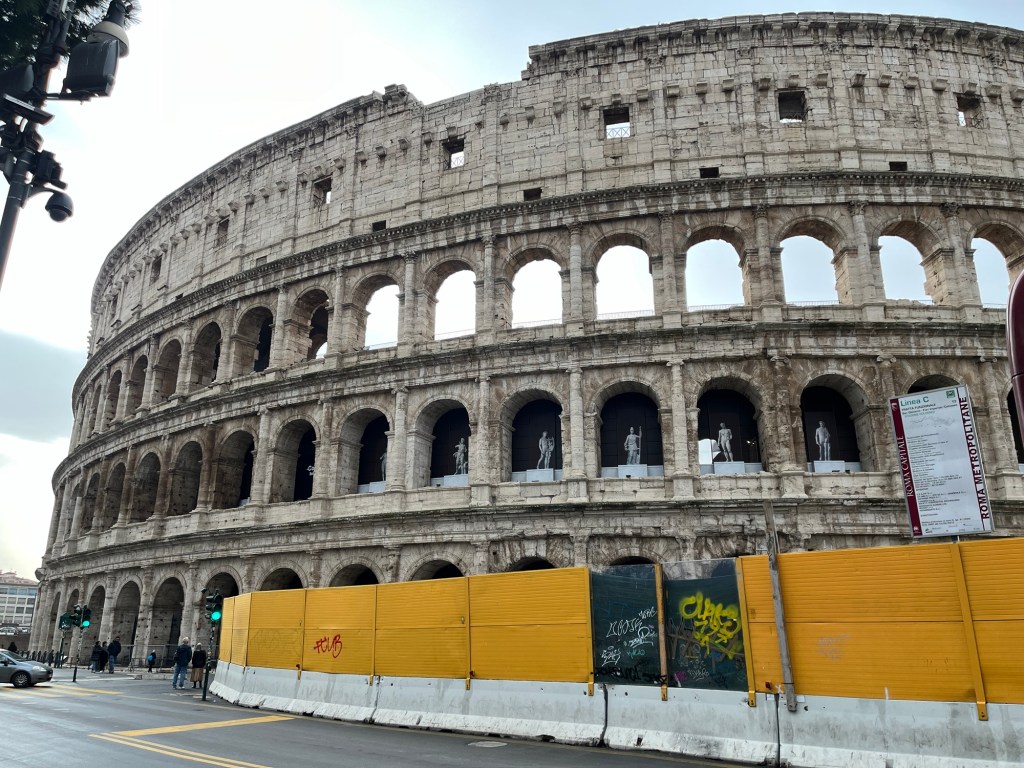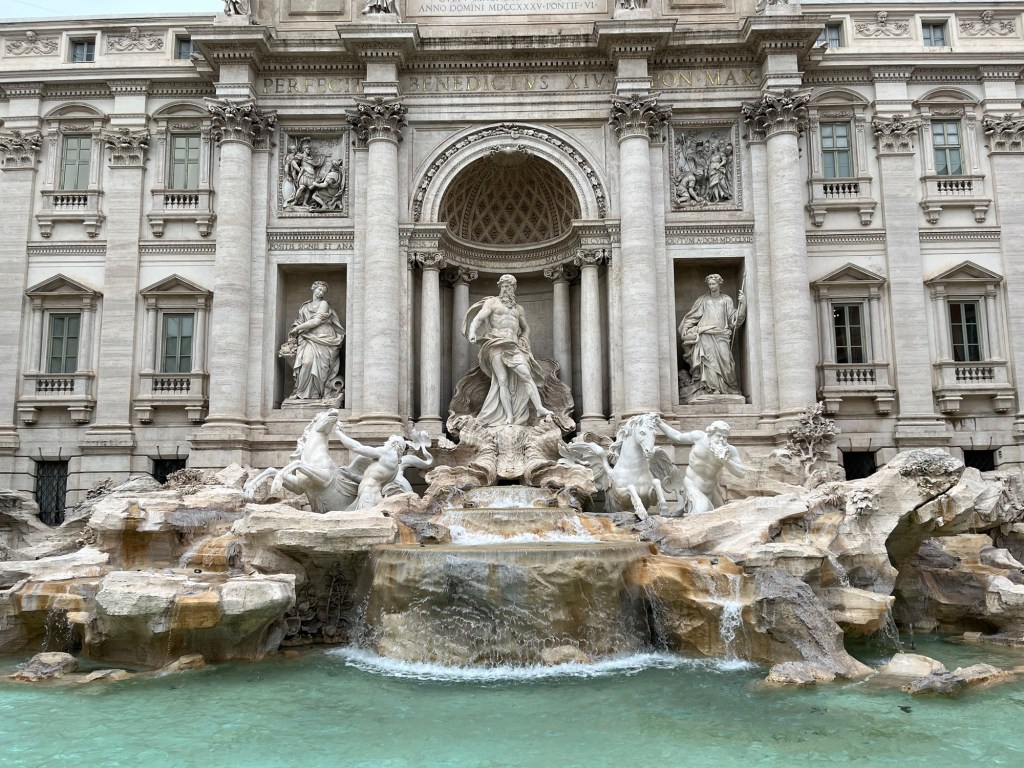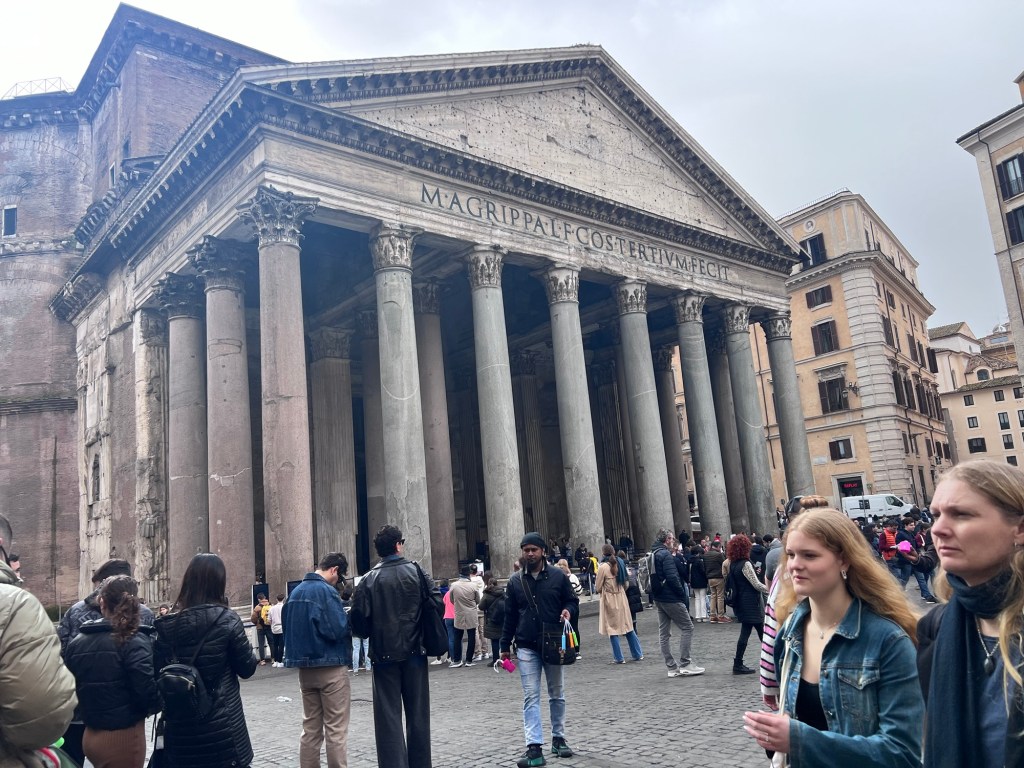Our flight from Brussels was in the afternoon so we didn’t arrive to Rome until that evening and after an hour train ride to the city center we were already pushing 8:00. Our hotel was about a 45 minute walk from the Termini train station, so we were able to experience the eternal city at night for the first time.
Colosseum
The first thing that hits you while wandering the city is that you’re never too far from something ancient. For instance, we were about a quarter mile from the train station and through an ally saw an illuminated Colosseum. A little ways further and you’re at the Roman Forum, so on and so forth. Even though the antiquities are scattered across the city, the churches within Rome are even more densely populated. Don’t take my word for it but I’m convinced that there’s one within every block of the city. In total, however, the city has more than 300 churches (99% of them being Catholic) so it isn’t too far of a stretch. Before we hit the most famous of churches, we had a full day of antiquities to see. We scheduled three formal tours during our four day stint in Rome and the first was at the iconic Colosseum followed by the Roman Forum.

Side bar – If you talk to anyone about visiting Rome for the first time, they’ll mention a few things. The first is to (obviously) see the historic sights that the city has to offer but the second and most important is to secure a ‘skip the line’ ticket at the Colosseum and Vatican. When we were researching tours to choose from, these types of tours were always popping up at a $20 per person premium compared to the normal tickets and when we arrived at 7:30 that Wednesday morning we fully understood why these exist. While our tour began at 7:30, we were in the Colosseum at 7:45 and looking at the line to enter, I can only assume that folks were standing in line for hours beforehand and was stretching and winding for as far as I could see. Our guide handled all of the logistics and we simply followed her through the crowd and were early enough to be isolated from the rest of the mob. In short – if you’re visiting Rome for the first time, pay the extra $20 and get these tickets.
The Roman Colosseum is really a sight to see. As Lauren and I were walking from the train station to our hotel the first night, we saw glimpses of it between buildings and down alleys but actually coming face to face with it and looking from within it, is truly spectacular. Our tour began with what’s known as the ‘Gladiator’s Gate’, where we entered the amphitheater in the underground corridors. In the labyrinth of these passages, lay shadows of previous slaves, trained to fight each other or exotic beasts as gladiators until the death. To the east of the Colosseum lies the remains of Ludus Magnus, which was the training center for gladiators with each building being connected by an underground tunnel that still exists. Before combat, the gladiators would arrive from Ludas Magnus out of sight and arrive to the arena floor often to a thunder of blood thirsty spectators. We were guided along this route, which includes flat arches that are only held up by the weight of the building and a replica of ancient lifts that were used to bring lions, bears, elephants and rhinos to the area floor. Once we transverse the length of the area, we took the (original!) gladiatorial staircase that opened to the arena floor.



I could write a few thousand words on the Colosseum based on what we learned (for instance, it was originally known as the Flavian Amphitheatre, named after the Flavian dynasty that was in place during its construction, and is thought to be referred to as the Colosseum as the Colossus of Rhodes was positioned beside the amphitheater) but I’ll spare you all that. While we began our tour the way the gladiators would have experienced it, there are certain parts of the Colosseum that are segmented and depending on what type of ticket you purchase, you can only see so much. We splurged on what’s known as the ‘Gladiator’s Gate’ package that included the underground, arena floor and the 2nd floor.


Roman Forum
Following the Colosseum tour, we were off to the Roman Forum, the center and heart of the ancient empire. Constructed around 800 BCE, the forum was the main gathering point for Romans and included many government building and shops where locals would go about their business. In addition to the governmental and shopping experiences, the forum was often used for public executions, like Caesar’s (that didn’t happen in the colosseum) and for long, triumphal processions to help celebrate a successful conquest and reaffirm the power of the Roman Empire. For those showy leaders, triumphal arches were also built including the Arch of Septimius Severus and the nearby Arch of Titus.


Other Rome Sights
After our tour concluded and armed with just our wits and an offline google map, we set off to hit the rest of the sights on our own. We headed northwest to Piazza Navona, a huge public piazza that originally housed the Stadium of Domitian which was used for competitive athletics. On the surface, its just a large public gathering place but in the 17th century the Baroque design was inspired by the likes of Borromini and Bernini some of the most famous architects of their time. I’m was never an Art History buff but I’m told this is very impressive.

We continued our trek and our next stop was the Trevi Fountain located at the intersection of Via De’Crocicchi, Via Poli and Civa Delle Muratte which gives it its namesake (tre via, trevi, three streets). Constructed almost entirely out of travertine, the fountain was constructed in the mid 18th century by Salvi and Pannini and is the largest Baroque fountain in the city. The scene is based in Greek mythology and depicts Oceanus, a Greek god that personifies the sea, taming hippocamps, a sea-horse with a upper boy being a horse and the lower body being a fish, with the helps of some tritons. Looking at modern superstition, it is said that if you throw a coin with your right hand over your left shoulder, you’re destined to return to Italy. This superstition is so prevalent that it’s estimated that over 3,000 euros are thrown into the fountain every day, which the Roman government uses to help the poor.

Our last stop was the infamous Pantheon. It was constructed in the early 1st century BCE as a pagan temple and later was given over to the catholic church dedicated to St Mary and the Martyrs. Even through Italy’s war torn history and many earthquakes, the Pantheon is one of the most well preserved ancient Roman buildings. The highlight of the building itself is the concrete dome, the world’s largest unreinforced concrete dome and in its center the 30ft diameter oculus, an hole that allows the elements inside and is the church’s sole source of light. Due to crowds, general laziness and irritability (the Pantheon was open to the public and free to enter up until the summer of 2023, where they added queues and a ticketing process), we did not go inside. Will I regret it? Probably.

Travel/Post Details:
- Post includes activities from February 27-28
- Accommodation: Relais Giulia
- Featured Image: Vittorio Emanuele II Monument the night we arrived in Rome
- Meal Details:
- Dinner on the evening of February 27 was at La Masardona where they specialized in fried pizzas. I had a prosciutto and mozzarella fried pizza and Lauren had a traditional Napoleon Margherita.
- February 28
- Coffee this morning was at Bar Farnese about a 10 minute walk from our hotel. The place was tiny and ran by a very kind older gent. Not only was he and the barista very kind but the espresso is top notch and the best we had during our entire stay in Italy. Highly recommended to visit when going back.
- Lunch at Taverna Agape. A small restaurant we found after our tour. I finally had a mussel dish (albeit not in Brussels) mussels and spaghetti and Lauren had Strozzapreti with Casarecci con Ragù di cinghiale.
- Dinner was at Pastevere, a small pasta place with like six things on the menu. We split the carbonara and headed back to the hotel.
- We visited Gelateria La Romans twice in order to satisfy Lauren’s sweet tooth…not that I had any objections.
- Our Colosseum and Roman Forum tour was conducted by LivTours with Rossana who was very helpful and knowledgeable.
- On Feb 28, we also walked by the Vittorio Emanuele II Monument, colloquially known as ‘The Cupcake’ which was built to commemorate the king’s who unified Italy in the late 19th century and is also home to the Italian Tomb of the Unknown Soldier. We also saw Trajan’s column, a triumphal column that celebrates Trajan’s victor in the Dacian Wars and includes a bas relief, that winds around the column to tell the story
